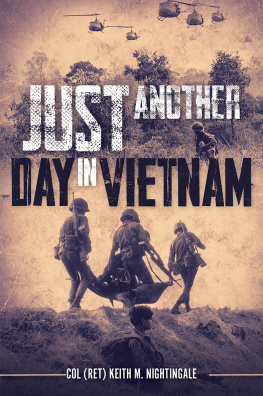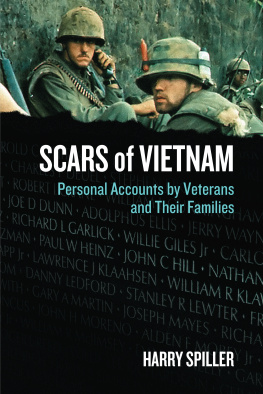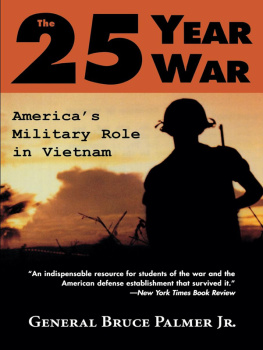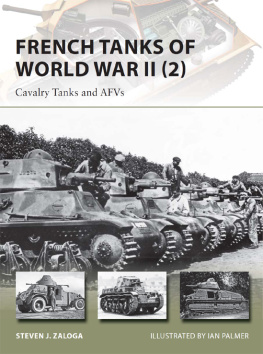Books by Keith W. Nolan
House to House: Playing the Enemys Game in Saigon, May 1968
Ripcord: Screaming Eagles Under Siege, Vietnam 1970
The Battle for Saigon: Tet 1968
Sappers in the Wire: The Life and Death of Firebase Mary Ann
A Hundred Miles of Bad Road: An Armored Cavalryman in Vietnam, 196768 (with Dwight W. Birdwell)
The Magnificent Bastards: The Joint Army-Marine Defense of Dong Ha, 1968
Operation Buffalo: USMC Fight for the DMZ
Into Cambodia: Spring Campaign, Summer Offensive, 1970
Into Laos: The Story of Dewey Canyon II/Lam Son 719, Vietnam 1971
Death Valley: The Summer Offensive, I Corps, August 1969
Battle for Hue: Tet 1968
Search and Destroy


The Story of an Armored Cavalry Squadron in Vietnam: 1-1 Cav, 19671968
Keith W. Nolan


For Britt, of course, of whom I could not be more proud... and Kristin
Lynn Halbert, to whom I could not be more thankful...
Yea, though I walk through the valley of the shadow of death,
I shall fear no evil, for I am the meanest motherfucker in the valley.
Charles Nathan Boyd
1st Armored Division
Vit Nam, 19671968
You got arms and legs on that one, Three Five.
David Earl Roesler
1st Armored Division
Vit Nam, 19671968
Contents
Introduction
FORTY YEARS REMOVED FROM the events in question, a certain amnesia, bordering on whitewashing, has developed regarding the realities of General William Westmorelands search-and-destroy war in South Vit Nam.
A vivid reminder seems in order. One unit intimately involved in the search-and-destroy war, the 1st Squadron of the 1st Cavalry Regiment, originally arrived in Vit Nam during the summer of 67. The squadron, which made war from tanks and armored assault vehicles known as tracks, reinforced the ongoing campaign in I Corps, the most northern of the four tactical zones into which South Vit Nam had been divided. High casualties were the price of admission for units that operated in I Corps, and, indeed, most members of the squadron not killed or seriously wounded accumulated at least one or two flesh wounds during their tours of duty. The allies faced two implacable foes in I Corps: Vit Cng guerrillas who planted mines amid the villages of the coastal lowlands and the light infantrymen of the North Vietnamese Army, who ventured from the mountains to the west to make conventional war, resupplied and replenished as they were through Laos.
Tough troopers for a tough war, the young men of the 1-1 Cavalry gave as good as they got. Mostly draftees, they had little use for the army and played by their own rules, loading coolers of beer into their tanks and tracks along with the ammunition. Led by professionals, however, and confident in their firepower, they were ferocious in battle, routinely racking up lopsided body countsten to one, fifty to one, a hundred to oneover the VC and NVA.
Veterans of the 1-1 Cavalry, a tight bunch indeed, remain immensely proud to have known such good men as those they fought beside at places like Cigar Island, the Pineapple Forest, and the Qu Sn Valley. If you ask, they will tell you of the young trooper who walked down a line of enemy entrenchments, methodically killing NVA in their spider holes until felled by a grenade, the platoon sergeant who took on a trenchful of VC with his pistol, the pugnacious lieutenant who waited for the medevac with a cigar and beer after losing an arm, or the sergeant and medic who raced headlong into a fatal crossfire while attempting to rescue a wounded infantryman from a different unit. Such was the bond between American GIs in Vit Nam.
In old photographs, the battlefields appear beautiful: beaches as white as paper, vibrant green meadows and rice paddies, mountains on the horizon, and oasis-like islands rising from the farmland upon which villagers built thatch hootches under palm trees. The enemy transformed these islands into bunker complexes. When contact was made, the tanks and tracks would bring smokethat is, line up and pour on the firepowerbefore advancing relentlessly into the trees, ignoring the tracers zipping past and the rounds ricocheting off gun shields and turrets. After the bunkers had been silenced, dismounted cavalrymen would root diehards from tunnels with grenades and plastic explosives, while helicopter gunships fell like birds of prey upon those battered enemy still alive and trying to escape. The officers and men of the 1-1 Cavalry were rewarded for the aggressive conduct of their operations with fistfuls of Bronze and Silver Stars, plus three Distinguished Service Crosses during the period covered here, and a Congressional Medal of Honor.
That is the war most veterans want preserved in print. Press a little deeper, however, ask uncomfortable questions about what search-and-destroy really meant at the ground level, and the picture begins to smudge around the edges. These men had been sent to fight a war in which the enemy, originally nicknamed Charlieas in Victor Charlie, the VChad since been dehumanized as Gooks, Dinks, Slopes, and Zips. The same epithets came to be applied to all things Vietnamese, whether friend, foe, or civilian. If some veterans speak openly about this reality, most acknowledge the dark side of their memories only reluctantly, for an outsider couldnt possibly understand the accumulation of frustrations that led otherwise normal young men to run people off the road for fun or use water buffalo for target practice. That was just the beginning: there were also the villagers who were beaten, the hamlets that were torched, the prisoners who never made it back to the rear. Most disturbingly, there were the troopers who came to enjoy killing; unmoored from the real world, convinced that they were dead men walking, they operated in a fugue state in which it seemed somehow right and normal to toss grenades into shelters occupied by women and children, or use a machete to hack the head from a slain Vit Cng.
Explanations dont suffice. Realities shift. Consider these stories from different angles, and you can find justification in them for any view you prefer about the conduct of the United States Army in Vit Nam.
Its all here, and it all happened.

Notes
Vietnam or Vit Nam?
Throughout this book the reader will see Vietnamese names and places with the Vit diacritical marks. This is to honor the people of Vit Nam, who were so afflicted by the many years of war in their countryside and cities.
In addition, in Vietnamese, every syllable is written as a separate word. Thus, Saigon or Hanoi for us but Si Gn or H Ni for them.
When Vit words are seen inside quotes of American soldiers, however, they are written in the American style.
Next page












